Content Distribution Plan: How to Conquer Declining Organic Reach
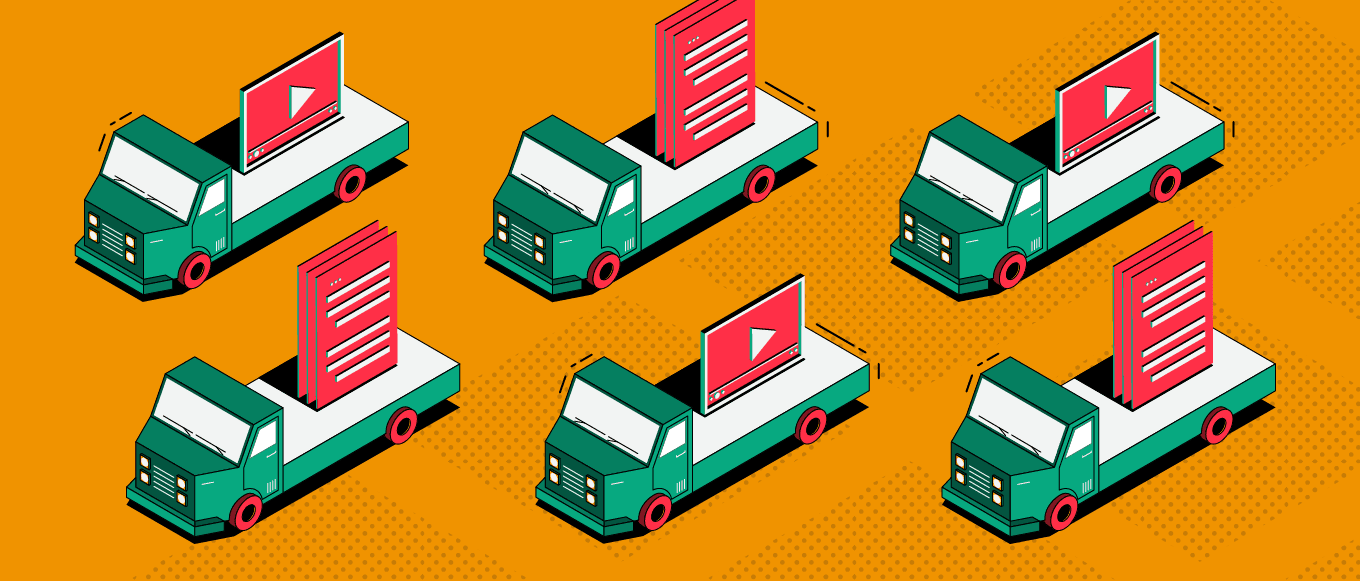 The average blog post takes over three hours to write, marketers are told that videos need to be 10–18 minutes in length to keep someone’s attention, and the typical duration of a podcast comes in at more than 43 minutes. Not to mention the extra time you’ll spend editing each type of content to make them publish-ready.
Yet, with so much time being invested in content creation, we seem to be forgetting about promotion. After all, if anyone doesn’t see your content, was it really worth creating?
The only problem is that distributing content is hard. Social media algorithms are forcing publishers to pay to play. Increased SEO competition also makes ranking for your target keywords even harder.
In case you were curious: there are over 1.4 billion results for “content distribution”, and we’re competing with all of them.
You need a content distribution plan that makes sure your content — be that a video, podcast, or something entirely different — is seen by your target customers. That’s the only way to get a return on your content investment.
The average blog post takes over three hours to write, marketers are told that videos need to be 10–18 minutes in length to keep someone’s attention, and the typical duration of a podcast comes in at more than 43 minutes. Not to mention the extra time you’ll spend editing each type of content to make them publish-ready.
Yet, with so much time being invested in content creation, we seem to be forgetting about promotion. After all, if anyone doesn’t see your content, was it really worth creating?
The only problem is that distributing content is hard. Social media algorithms are forcing publishers to pay to play. Increased SEO competition also makes ranking for your target keywords even harder.
In case you were curious: there are over 1.4 billion results for “content distribution”, and we’re competing with all of them.
You need a content distribution plan that makes sure your content — be that a video, podcast, or something entirely different — is seen by your target customers. That’s the only way to get a return on your content investment.
Content Distribution: A Complete Guide to the Methods That Work Best
Click To TweetOrganize Your Content Distribution With This Marketing Calendar Bundle
How can you make sure each piece of content you publish is effectively distributed? Start by planning all your distribution tactics on a marketing calendar. This kit includes several calendar templates for planning content marketing, social media campaigns, email sends, and more. If you’re doing to do something, put on the calendar:What Does Content Distribution Mean?
Here’s a simple definition we can work with: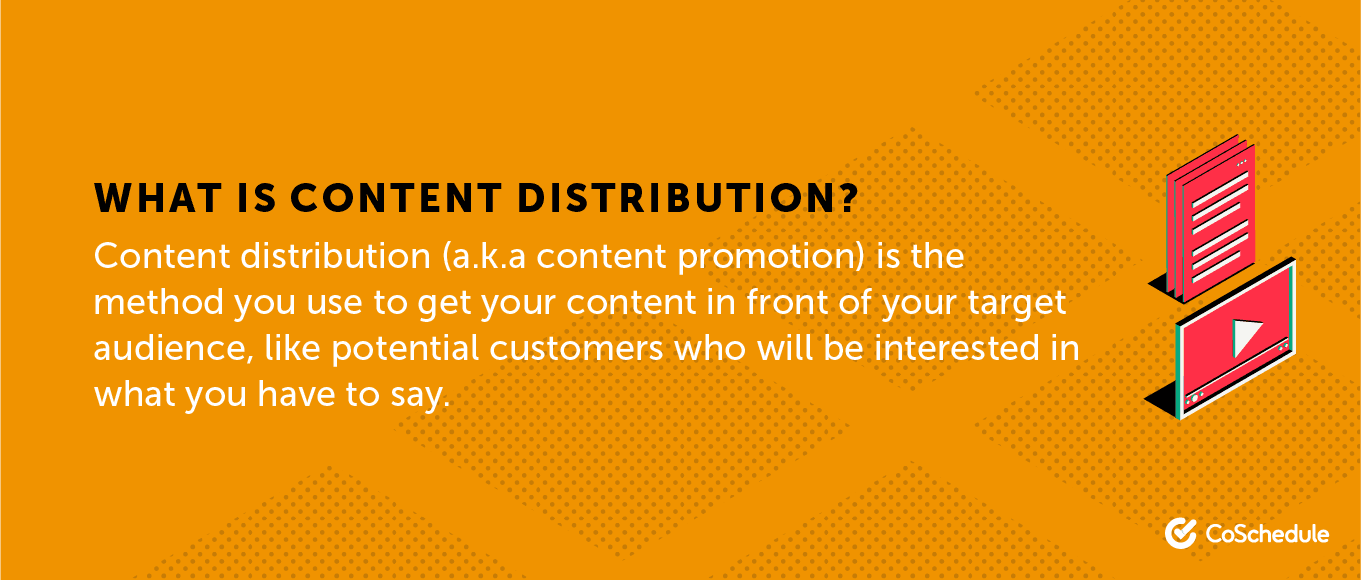 Ross Simmonds does an excellent job breaking down the topic and providing a solid checklist, if you’re more of a visual learner.
Before we go any further, it’s worth clarifying that “content” doesn’t always mean written text. You can follow the same distribution tactics for any type of content, including videos, podcasts, or slideshows.
Ross Simmonds does an excellent job breaking down the topic and providing a solid checklist, if you’re more of a visual learner.
Before we go any further, it’s worth clarifying that “content” doesn’t always mean written text. You can follow the same distribution tactics for any type of content, including videos, podcasts, or slideshows.
Importance of Content Distribution
Brand awareness is a huge goal for many marketers. That, combined with the trust earned through content, is a key reason why businesses invest so heavily into content marketing. However, it only works when you’re reaching the right audience. Shiny object syndrome quickly creeps into most editorial calendars.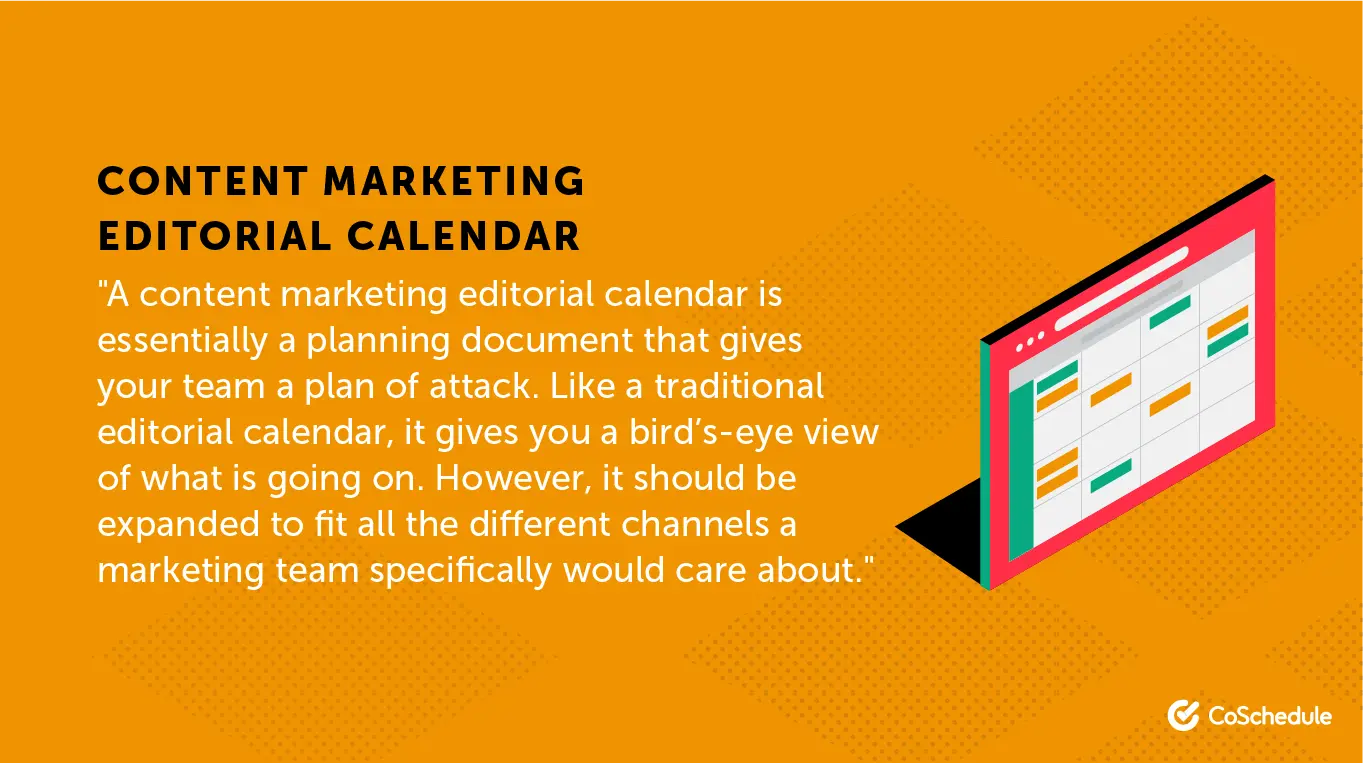 After all, when you’ve spent hours creating a piece of content, it’s not uncommon to quit on your idea and start working on the next shiny, new thing. The problem here is that when you’re creating content, publishing it into the void, and never encouraging anyone to visit it, all of that hard work was completed for nothing. You’re essentially wasting the time you spent creating it in the first place.
It’s why of the B2B marketers who said they were struggling to see content marketing success,a third said they were facing distribution issues.
A content distribution plan solves that problem.
You’ll maximize the mileage you get from your content — not only by making the time investment worth it, but by bringing more readers to your website. That’s what will make your content reach your marketing goals.
After all, when you’ve spent hours creating a piece of content, it’s not uncommon to quit on your idea and start working on the next shiny, new thing. The problem here is that when you’re creating content, publishing it into the void, and never encouraging anyone to visit it, all of that hard work was completed for nothing. You’re essentially wasting the time you spent creating it in the first place.
It’s why of the B2B marketers who said they were struggling to see content marketing success,a third said they were facing distribution issues.
A content distribution plan solves that problem.
You’ll maximize the mileage you get from your content — not only by making the time investment worth it, but by bringing more readers to your website. That’s what will make your content reach your marketing goals.
What Parts of Content Distribution Are Broken?
Before we get into the technicalities, let’s iron out why “traditional” content distribution no longer works.Social Media is Saturated
These days, people treat social media as their source of news. They head to sites, like Facebook and Twitter, to see what’s going on in the world. Sounds like a positive thing, right? It was — up until every publisher found the power social media has in content distribution. Now, it’s the go-to place for startups and massive media publications to share content. What does this mean?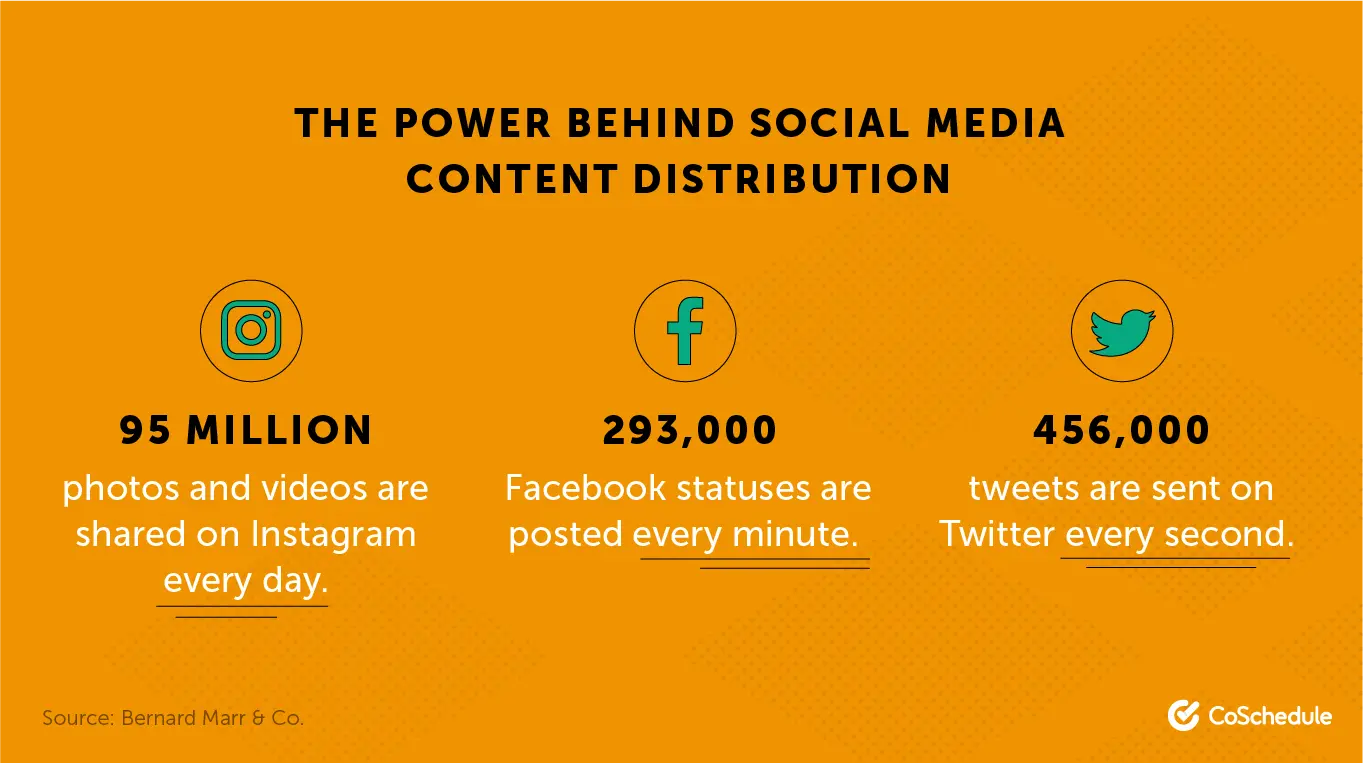 You’re waging the war against that barrage of social media content in a bid to get your audience’s attention.
You’re waging the war against that barrage of social media content in a bid to get your audience’s attention.
Social Media Algorithms Make Content Hard to Find
Did you know that fewer than 6% of a Facebook Page’s followers will see an organic post? Source:Hootsuite
No matter how long you’ve spent building a page, it likely won’t be seen by as many followers as you’d expect. That’s due to the decline of organic reach on social media — especially on Twitter and Facebook.
Social media sites are pushing brands towards their advertising platform, since that’s where the money is. They don’t earn any money from organic posting; they’re making up for it by limiting how many people can see a brand’s free content.
To reach all of your page’s followers, you’ll need to boost the post — something that will set you back a minimum of $1 per day. Even then, you’re not guaranteed to reach all of your followers.
Here’s what that means in blatant terms: if you don’t pay to promote your content on social media, it probably won’t be seen by the audience you’ve spent so long building — even if thousands of people have already chosen to see content from you in their feed.
Source:Hootsuite
No matter how long you’ve spent building a page, it likely won’t be seen by as many followers as you’d expect. That’s due to the decline of organic reach on social media — especially on Twitter and Facebook.
Social media sites are pushing brands towards their advertising platform, since that’s where the money is. They don’t earn any money from organic posting; they’re making up for it by limiting how many people can see a brand’s free content.
To reach all of your page’s followers, you’ll need to boost the post — something that will set you back a minimum of $1 per day. Even then, you’re not guaranteed to reach all of your followers.
Here’s what that means in blatant terms: if you don’t pay to promote your content on social media, it probably won’t be seen by the audience you’ve spent so long building — even if thousands of people have already chosen to see content from you in their feed.
Cold Outreach Promoting Content Has Become Spammy
A few years back,cold email outreach was an effective way to promote your content and get backlinks while doing so. Marketers cottoned onto that and overdid it — which means that, now, most cold outreach emails come across as spammy. The people who default to “Hello Sir/Madam,” overused templates, and make it obvious they found your email through a scraping tool and ruined cold emails’ reputation. Source: Voila Nobert
Even if you’re cold emailing with good intentions, it’s hard to break that barrier because people have grown to not trust them.
Source: Voila Nobert
Even if you’re cold emailing with good intentions, it’s hard to break that barrier because people have grown to not trust them.
SEO is Extremely Competitive
SEO is the foundation of most content distribution strategies because search engines’ main goals are to connect searchers with content that solves their question, gives them information, or helps them buy something. In other words: the whole purpose of SEO is to reach people already looking for your content. However, SEO has gotten extremely competitive. It’s not just popular phrases, like “how to start a blog”, where you’re competing with millions (if not billions) of other websites. Niche phrases, like “how to disable usb port in windows 7 using cmd”, are still being targeted by 31 million+ sites: It gets worse.
You can have high-quality content and still not get anywhere near page one.
The authority, reputation, and history of your entire website come into play when Google decides where to rank a piece of content — with its quality making up only a small portion of ranking decisions.
It gets worse.
You can have high-quality content and still not get anywhere near page one.
The authority, reputation, and history of your entire website come into play when Google decides where to rank a piece of content — with its quality making up only a small portion of ranking decisions.
The authority, reputation, and history of your entire website come into play when Google decides where to rank a piece of content — with its quality making up only a small portion of ranking decisions.
Click To TweetWhat Are Some Common Content Marketing Distribution Channels?
Are you ready to start distributing your content without falling into one of those broken promotion strategies? Here are three key distribution channels to get you started.Search Engine Optimization (SEO)
We just touched on the fact that SEO is competitive, but if you get it right, you could see millions of people come to your site every month — without necessarily having to go out and do something to see a spike in traffic. That’s because search engines exist to connect people with content. People are already searching for the content you’re creating. By optimizing it for SEO, you can reach them whenever they’re looking for your content — as opposed to forcing it onto their Facebook timeline when they just want to passively scroll through their friends’ posts. It’s why organic search recently overtook social media in the most popular content distribution channel for marketers:
Social Media
Despite the saturation, social media still is a great way to distribute content. There are over 4.2 billion people using social media across the world, each spending an average of 145 minutes on platforms like Facebook, Instagram, and Twitter every day. That’s a huge pool of potential readers you can target with your existing content. Distributing your content on multiple social media platforms gives you a shot at reaching them.Email Marketing
Did you know that 87% of B2B marketers use email marketing to distribute their content? It falls just behind social media in terms of popularity. Email marketing works so well as a distribution channel because you’re promoting your content to people who’ve already expressed interest in your brand and what you share. Subscribers have already opted in to hear from you, so use that to your advantage and treat your email list as a vehicle to deliver content to readers.Understanding Paid vs. Owned vs. Earned Media
Expanding how you distribute your content, and not just relying on social media sites to show off your work, is the secret to building a distribution engine. To do this, you’ll need to use three distribution channels:
Owned Distribution
Owned channels are platforms you have complete control over. Nobody can take your audience away from you; it’s yours to do what you wish once you’ve built it. This can include:- RSS
- LinkedIn/Facebook Groups
Earned Distribution
In the case of earned distribution channels, someone else essentially controls it, but you’ve put in the work to earn an audience there. Some examples include:- SEO
- Forums (e.g. Quora)
- Upvoting sites (e.g. Indie Hackers,Growth Hackers, and Reddit)
- Medium
- Slideshare
Paid Distribution
This distribution channel is pretty self-explanatory; you give cash in return for reaching an audience owned by someone else. That might include:- Paid social
- Google Ads
- Native advertising through platforms (e.g.Outbrain)
- Content curation submission sites (e.g. Quuu Promote or Zest)
How to Approach Content Distribution
Are you ready to make a content distribution plan that gets your content in front of your target reader?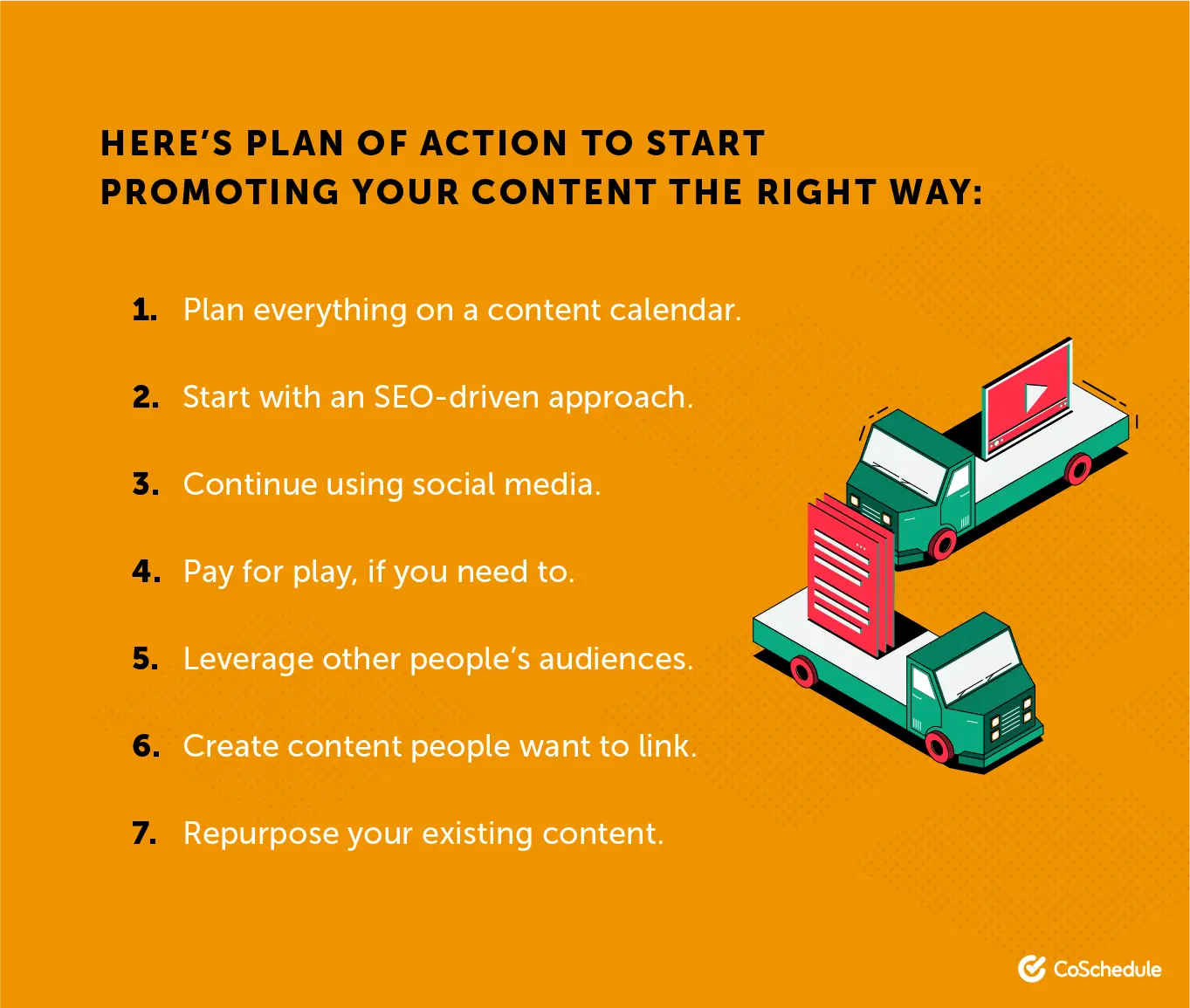
Are you ready to make a content distribution plan that gets your content in front of your target reader?
Click To Tweet1. Plan Everything on a Content Calendar
There’s a fine line between not promoting content enough and annoying people by sharing it too much. Get a visual understanding of how often you’re promoting your content by using an editorial calendar. This can be as simple as a spreadsheetthat details:- What you’re promoting
- Which channel you’re sharing it on
- The date and time you’ll be posting it

2. Start With an SEO-Driven Approach
Earlier, we talked about how SEO is a competitive space. You need more than high-quality content to reach the top spots, so make sure you have the basics covered, like a technically-sound website structure, optimized page layout, and some backlinks. More on that later. The good news is that it’s possible to drive traffic through search engines — you just need patience and realistic goals. In this case, SEO informs your entire content marketing strategy, starting with brainstorming the content you should be creating. Start by targeting terms you can rank for. These are keywords or phrases that:- Have low keyword difficulty
- Have a high search volume
- Are relevant to your business’s core offering
3. Continue Using Social Media
Chances are, you’re using social media in the way most other publications are, so boost your chances of social media promotion working for you by continuing to use social media — with a few tweaks. The first being to tag other accounts in your content. If you’ve quoted someone in your content, for example, pull their quote and tag their Twitter handle when promoting it on Twitter. You’ll reach their audience if they retweet or engage with it. In most cases, they will. Also, try to target trending topics with your content; it’s why the news is so popular and widely-shared. People want to read new, exciting things related to what’s going on at that moment. Kontentino did this by leveraging a talked-about topic (coronavirus) and tying it into their content. They posted that headline on Growth Hackers and got over 3,000 extra views on their post. Test different social media channels to see how each audience reacts to your content.
Facebook is the primary content distribution channel for marketers today, according to HubSpot. However, different audiences react to different channels. You might find that content shared to Facebook doesn’t get anywhere near the number of social shares than content posted to LinkedIn does, for example.
The key is to test multiple social media networks and invest the most effort into the distribution platforms where you get the best results.
Test different social media channels to see how each audience reacts to your content.
Facebook is the primary content distribution channel for marketers today, according to HubSpot. However, different audiences react to different channels. You might find that content shared to Facebook doesn’t get anywhere near the number of social shares than content posted to LinkedIn does, for example.
The key is to test multiple social media networks and invest the most effort into the distribution platforms where you get the best results.
4. Pay for Play
With social media algorithms making it harder for brands to reach their followers, the number of marketers using social media advertising/promoted posts increased to 83% from 60% over the last 12 months: Don’t be afraid to pay for play, if you need to.
Social media ads can be effective for large pieces of 10X content, like eBooks, white papers, and video content. You’re putting cash behind a piece of content directly attributable to business results, like views, leads, and subscribers.
Facebook Ads are typically the go-to platform for brands wanting to promote their content. It’s the biggest social network in the world and has millions of people you’re able to reach with little cash.
However, Massive Kontent’s Jason Thibault explains that Twitter ads are worth investing in, too:
Don’t be afraid to pay for play, if you need to.
Social media ads can be effective for large pieces of 10X content, like eBooks, white papers, and video content. You’re putting cash behind a piece of content directly attributable to business results, like views, leads, and subscribers.
Facebook Ads are typically the go-to platform for brands wanting to promote their content. It’s the biggest social network in the world and has millions of people you’re able to reach with little cash.
However, Massive Kontent’s Jason Thibault explains that Twitter ads are worth investing in, too:
The Twitter ad platform is still one of the most underrated and underutilized content distribution tactics on the web. Marketers tend to use them incorrectly and then give up immediately. Twitter ads are not Facebook ads. Use them to start a conversation with your audience. You can run straight up ads ('dark posts'), carousel posts, videos or promoted Tweetstorms. Twitter custom-tailored audiences are your secret weapon. With tools such as Followerwonk, Ahrefs, Buzzsumo, and some Google Sheets API add-ons you can assemble audiences built around your competitors, hot content topics and popular hashtags. If you want to build up your Twitter following while also distributing content you can make video ads work twice as hard for you. Targeted video views can be bought on Twitter for pennies which make for a very affordable retargeting audience for future content promotion.Regardless of which platform you choose to advertise your content on, always set KPIs to stop your budget from running away from you. Metrics like:
 … all give a good indication of how your paid audience is reacting to your content. Keeping an eye on them — and knowing when to turn the ads off — keeps your budget tight and spent in the best way.
… all give a good indication of how your paid audience is reacting to your content. Keeping an eye on them — and knowing when to turn the ads off — keeps your budget tight and spent in the best way.
5. Leverage Other People’s Audiences
Don’t have an existing audience to use when promoting your content? That doesn’t mean you have zero audience altogether. Content distribution is easier when you can leverage other people’s audiences. Also known as “partner” marketing, you can buddy-up with other people in your space and help each other out. Some examples include:- Quoting experts in your article, then asking them to share it with their subscribers/followers when it gets published.
- Working with partners to get content placed in their email newsletters.
- Pitching your content to bloggers to get placed in roundups with other similar content.
- Speaking on podcasts to talk about the topic your content is about.
6. Create Content People Want to Link
Backlinks are a crucial part of any content distribution strategy. Links from other websites to your own improve your site’s overall authority, as well as the page you’re trying to promote. That helps build the SEO momentum we discussed earlier. So, what does link-worthy content look like? This can be as simple as a round-up post. Take Databox, for example; the majority of their content marketing strategy is round-up posts. They ask marketers for their opinions, compile data, and share them in a neatly-packaged blog post. Their round-up of software marketing tools did exactly that. The result? Over 170 backlinks and hundreds more social shares: You could also conduct original research with stats others can reference and cite as a source. That way, when people are searching for “marketing statistics”, they’ll find your content and link back to it — fueling the SEO cycle.
If you have the budget and resources, consider creating web-based tools. These can be:
You could also conduct original research with stats others can reference and cite as a source. That way, when people are searching for “marketing statistics”, they’ll find your content and link back to it — fueling the SEO cycle.
If you have the budget and resources, consider creating web-based tools. These can be:
- Calculators
- Quizzes
- Interactive infographics

7. Repurpose Your Existing Content
Not every piece of content needs a unique distribution material. Think about it: if you already have a blog post that’s ranking on page two of Google, you could repurpose and re-optimize that guide to make your SEO distribution network work harder. Repurposing applies to any other channel. You could turn one foundational piece to create different types of content, such as:- Turning case studies into Slideshare decks
- Using blog post graphics on social media
- Sharing content via email
- Turning webinars into 30-second Facebook video ads
- Reusing blog posts around a topical area and turning them into courses you can monetize
- “On YouTube: As a playlist that you can position as a course.
- On Twitter: Threads of each individual video so that you can post it throughout a week or more, depending on the number of videos.
- Via Email: You can increase your newsletter subscribers by sharing this course over email as gated content.


